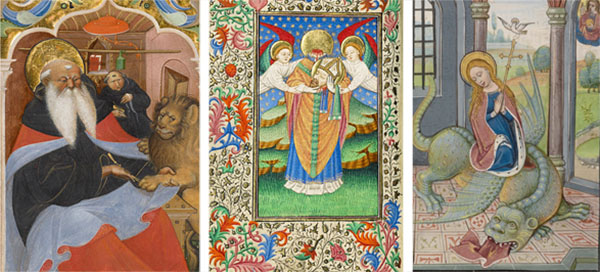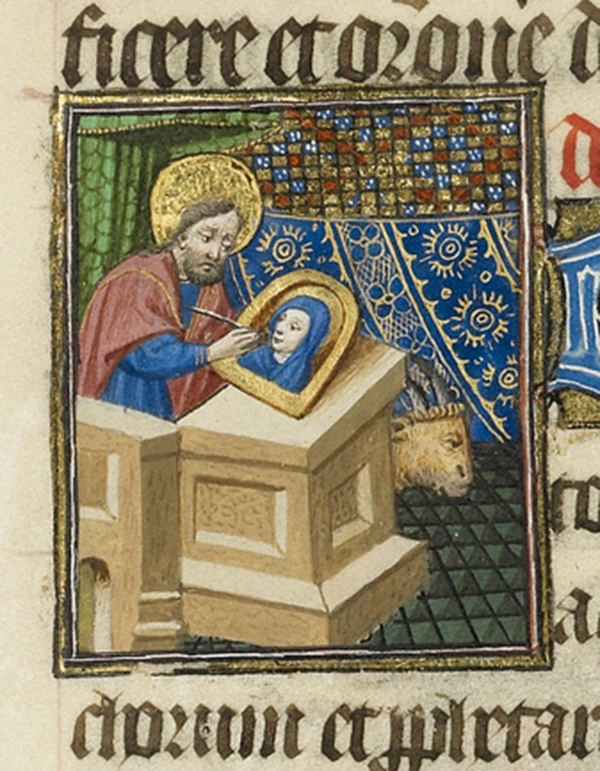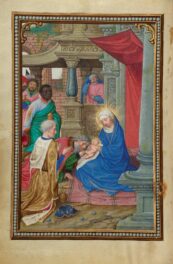
From city names to sports teams, saints and their legacies are all around us.
Throughout 2013, the Getty community participated in a rotation-curation experiment using the Getty Iris, Twitter, and Facebook. Each week a new staff member took the helm of our social media to chat with you directly and share a passion for a specific topic—from museum education to Renaissance art to web development. Getty Voices concluded in February 2014.—Ed.
Saints are all around us, part of our daily lives whether we realize it or not. Plastic statues of Saint Christopher watch over commuters from the dashboard, 70,000 football fans in a New Orleans stadium chant “Saints, Saints, Saints!,” and we say the names of American cities from Saint Petersburg (FL) to Saint Louis (MO) to Santa Barbara (CA) without giving much thought to the individuals they are named for.
In the Middle Ages, Christian saints were even more consciously ingrained in everyday life. The dramatic and remarkable stories and images associated with saints provided inspiration, comfort, and even entertainment.
Imagine a monk, rising at 2:00 am to say prayers, followed by a few hours of manual labor, silence during meals, and then, in the afternoon reading hour, he is plunged into tales of miracles, murder, and mayhem: Saint Jerome tames a wild lion, Saint Denis carries his own head around after his decapitation, and Saint Margaret uses a cross to cut open the belly of a dragon that had swallowed her.

Left: Saint Jerome Extracting a Thorn from a Lion’s Paw, about 1425–50, Master of the Murano Gradual. Tempera and gold leaf on parchment, 8 ¼ x 6 ½ in. The J. Paul Getty Museum, Ms. 106, recto. Center: Saint Denis Holding His Head (detail), about 1430–40, Master of Sir John Fastolf. Tempera colors, gold leaf, and ink on parchment, 4 3/4 x 3 5/8 in. The J. Paul Getty Museum, Ms. 5, fol. 35v. Right: Saint Margaret (detail) in the Arenberg Hours, early 1460s, Willem Vrelant. Tempera colors, gold leaf, and ink on parchment, 10 1/16 x 6 13/16 in. The J. Paul Getty Museum, Ms. Ludwig IX 8, fol. 57
Likewise, imagine a noblewoman with a toothache. She fears troubling God with such a small matter, so she turns to the page devoted to Apollonia in her prayer book, a saint who was martyred by having all her teeth pulled out and would no doubt be sympathetic to pleas for alleviating the pain.

The Martyrdom of Saint Apollonia, 1469, Lieven van Lathem. Tempera colors, gold leaf, gold paint, silver paint, and ink on parchment, 2 1/2 x 1 13/16 in. The J. Paul Getty Museum, Ms. 37, fol. 50v
Saints played an active role in the devotional life of the Middle Ages, both for those in religious orders and for lay people. But their stories, and the incredible images that medieval artists created of them, still mesmerize us today. That is why I and Melanie Sympson, former intern in the Department of Manuscripts, decided to mount an exhibition devoted to the theme of saints in the Middle Ages. Fortunately, our collection presents a vast array of possibilities to choose from, as probably fully three quarters of the manuscripts in the collection contain some kind of an image of a saint. In part, we focus on individual stories and images like those discussed above, but we also explore how saints formed part of the cultural weave of life in the Middle Ages.
For example, in the illumination below Saint Hedwig is shown paying homage to the pews, stairs, and even the hand towels used by the nuns in her convent. This act of humility might strike modern viewers as odd (or more than odd), but it demonstrated to those reading the manuscript that simple, humble acts could be symbolic of a truly faithful soul.

Saint Hedwig Exhibiting Humility in Life of the Blessed Hedwig, 1353, Court workshop of Duke Ludwig I of Liegnitz and Brieg. Tempera colors, colored washes, and ink on parchment, 13 7/16 x 9 3/4 in. The J. Paul Getty Museum, Ms. Ludwig XI 7, fol. 24
Hedwig was a noblewoman who gave up her life of ease and wealth to devote herself to God. She was also a saint who died a natural death after a lifetime as a wife and mother, rather than a young virgin martyred spectacularly for her faith, as many other female saints were. She could serve as a role model to medieval women leading regular lives, and provided inspiration to emulate her zeal for performing small acts of devotion.
In another scene, we see Saint Luke intent on drawing the perfect portrait of the Virgin Mary.

Saint Luke Painting an Image of the Virgin (detail) in a Book of Hours, about 1440–50, Workshop of the Bedford Master. Tempera colors, gold leaf, gold paint, and ink on parchment, 9 ¼ x 6 7/16 in. The J. Paul Getty Museum, Ms. Ludwig IX 6, fol. 209
According to legend, the first-century saint painted Mary from life more than once, creating a series of miraculous icons. Due to the fame of these portraits, in the Middle Ages most artist guilds were called the “Guild of Saint Luke,” as the saint was thought to provide them with special protection. In private prayer books such as the one that contains this image, the saint is often pictured diligently set at his task so readers could make a connection between Luke’s efforts to faithfully capture the features of the Virgin and the medieval artist’s beautiful craftsmanship before them.
One blip along the way to creating the saints exhibition, but a very welcome one, was the fact that the Manuscripts Department recently acquired an extraordinary new manuscript that we wanted to share with the public as soon as possible in our gallery. Ironically, it is one of the few manuscripts in the collection that contains not a single image of a saint. It is a wonderfully exciting tale about a medieval knight named Gillion de Trazegnies that combines romance, epic, and travelogue. It is illuminated with images filled with animated figures, breathtaking landscapes, and thrilling scenes of love and war. We are displaying it on a separate wall of the gallery, and although it lacks any saints, the story and images it contains resonate remarkably well with the drama and excitement seen throughout the rest of the gallery.

Gracienne Takes Leave of Her Father the Sultan (detail) in Roman de Gillion de Trazegnies, after 1464, Lieven van Lathem. Tempera colors, gold, and ink on parchment, 14 9/16 x 10 1/16 in. The J. Paul Getty Museum, Ms. 111, fol. 188v
One of the greatest pleasures of working with a manuscripts collection as exceptional and varied as the Getty’s is that there is always a new and thought-provoking theme to discover. In the future, we have plans to mount exhibitions looking at themes like chivalry, gift-giving, and the Italian courts.




Wonderful! I’m such a big fan of the Hedwig image and can’t wait to see Ms. 111 in person!